 |
 |
 |
| |
Virco Etravirine Clinical Cutoffs
|
| |
| |
Reported by Jules Levin
XVII HIV Drug Resistance Workshop
June 10-14, 2008
Sitges, Spain
Exploring Etravirine Resistance Among Recent Routine Clinical Samples Submitted For Resistance Testing
L Bacheler K Van Der Borght E Van Craenenbrosck, B Winters and P Lecocq, Vorco Lab, Inc Durhm, NC, USA, Virco BVBA, Mecheln, BE
BACKGROUND
Phenotypic susceptibility to efavirenz and nevirapine is significantly affected by single mutations in the viral genome resulting in elevated FC values and loss of clinical efficacy. In the DUET and other trials, etravirine has demonstrated significant clinical efficacy in patients with virus strains resistant to the first generation NNRTIs. In those trials, baseline etravirine phenotypic susceptibility was a strong predictor of virologic response. We evaluated etravirine susceptibility among a large dataset of recent routine clinical samples (RCS).
METHODS
Phenotypic susceptibility to NNRTIs (fold ⋅ change in IC50, FC) was calculated from the viral genotype (vircoTYPE v4.2.01) for 93,500 samples submitted to Virco for routine resistance analysis between Jan 2005 and Nov 2007.
Samples from clinical trials and research ⋅ collaborations were excluded from this analysis in order to focus on the types of samples/sequences being submitted for individual patient management
-- Efavirenz, nevirapine, and etravirine FC E were calculated by the VirtualPhenotype-LM bioinformatics engine, which utilizes multiple linear regression modeling of a large correlative database of viral genotypes and matching drug susceptibility phenotypes to assign resistance weight factors to mutations and pairs of mutations in order to provide an accurate prediction of the drug susceptibility phenotype (fold change in IC50, FC) from the viral genotype. (Vermeiren, et al.; Winters, et al., 2008). A separate model was developed and used for each NNRTI.
A subset of samples with genotypic evidence of ⋅ NNRTI resistance was identified based on the IAS-USA 2007 list of mutations associated with NNRTI Resistance (90I, 98G, 100I, 101E/P, 103N, 106I/M, 108I, 179D/F, 181C/I/V, 188C/H/L, 190A/S, 225H)
Etravirine FC values were classified as Maximal ⋅ Response (MA), Reduced Response (RR), or Minimal Response (Min) based on vircoTYPE HIV-1 clinical cut-offs of 1.6 (CCO1) and 27.6 (CCO2) associated with 20 and 80% loss of the predicted wild type response (Winters, 2008).
Because the RR category spans a broad FC range, ⋅ a further subdivision based on an etravirine FC of 5.0, associated with a 50% loss of response, was explored.
RESULTS
The Reduced Response category was further subdivided into samples with etravirine FC levels below or above 5.0, the VirtualPhenotype-LM calculated FC associated with 50% loss of response in the CCO study population.
-- Among RCS, 73.3%, 24.3% and 2.4% had ETR FC values classified as MA, RR, or Min, respectively.
-- 89.8% of RCS had ETR FC ≦5.0.
-- 38.4% of RCS had at least one NNRTI-resistance associated mutation.
Among these NNRTI resistant samples, 47.9%, 46.5%, and 5.6% had ETR FC values classified as MA, RR, or Min, respectively
-- 74.4% had an ETR FC ≦5.0.
-- Among samples in the etravirine RR category, 67.6 % of all RCS, and 57% of samples with NNRTI mutations had etravirine FC ≦5.0.
In the Duet studies, virologic response (undetectable viral load at Week 24) was observed in 69%, 59%, 49%, and 44% of subjects with baseline ETR FC <1.6, 1.6 to ≦5, 5 to ≦27.6, and >27.6, respectively.
SEE FIGURES & TABLES BELOW
DISCUSSION
Virtual Phenotype-LM models are drug specific; even within the NNRTI class, the mutations and pairs of mutations selected, and the weights assigned to mutations differ. The VirtualPhenotype-LM model for etravirine does not include K103N or S while variants at positions 179 and 181 were selected by the model as important for accurate calculation of etravirine FC.
The etravirine virco TYPE HIV-1 Clinical Cut-Offs established using the full dataset of phase IIb/III studies identify FC values at the beginning and end of a continuum of loss of clinical response as a function of increasing resistance. Substantial antiviral activity is still expected against isolates with FC in the Reduced Response category between these clinical cut-offs.
The virco TYPE HIV-1 Reduced Response Category (20-80% drug activity) can be further subdivided in a variety of ways. For etravirine, a FC of 5.0 was associated with 50% activity in the phase IIb/III CCO study population used to define and validate CCOs.
Almost 90% of our large dataset of recent routine clinical samples had etravirine FC values <5.0. Even among isolates with genotypic evidence of NNRTI Resistance, almost 75% had etravirine FC values <5.0.
Response to etravirine containing regimens, both in the Duet studies, and in the larger phase IIb/III CCO study population, declined gradually as baseline resistance to etravirine increased.
CONCLUSIONS
Most RCS, including those with evidence of resistance to first generation NNRTIs, had low ETR FC values, suggesting they might benefit from treatment with etravirine as part of a HAART regimen.

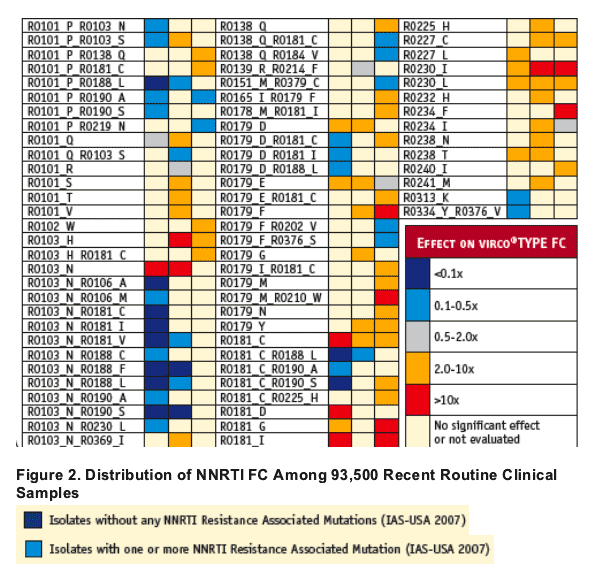
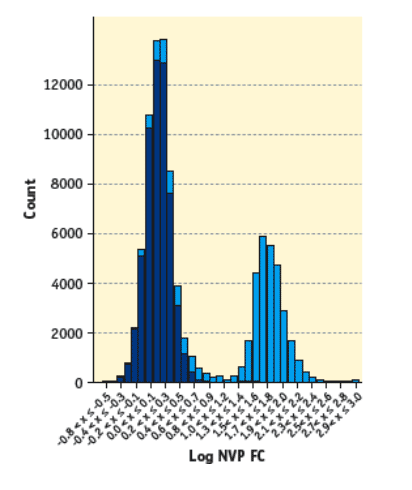
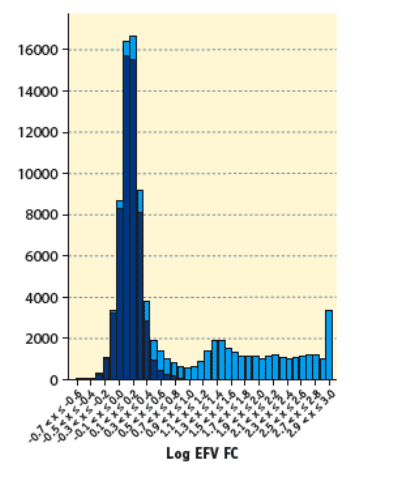
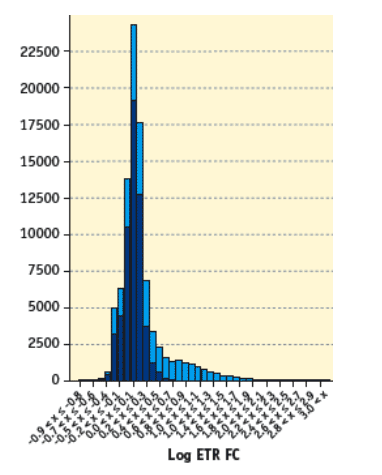

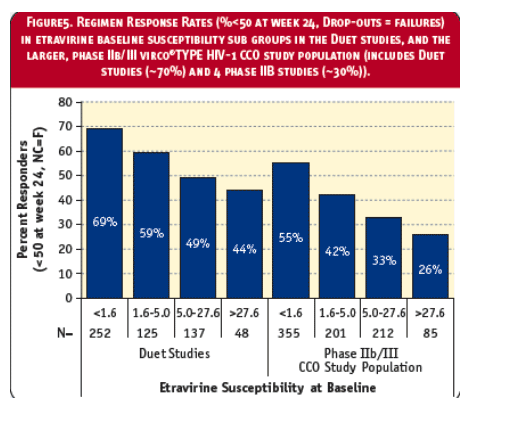
REFERENCES
1. Vermeiren H, Van Craenenbroeck E, Alen P, Bacheler L, 1. Picchio G, Lecocq P, Virco Clinical Response Collaborative Team. Prediction of HIV-1 drug susceptibility phenotype from the viral genotype using linear regression modeling. J Virol Methods. 2007 Oct;145(1):47-55. Epub 2007 Jun 15.
2. Winters B, Montaner J, Harrigan PR, Gazzard B, 2. Pozniak A, Miller MD, Emery S, van Leth F, Robinson P, Baxter JD, Perez-Elias M, Castor D, Hammer S, Rinehart A, Vermeiren H, Van Craenenbroeck E, Bacheler L. Determination of clinically relevant cutoffs for HIV-1 phenotypic resistance estimates through a combined analysis of clinical trial and cohort data. J Acquir Immune Defic Syndr. 2008 May 1;48(1):26-34.
3. Bart Winters, Vingerhoets J, Peeters M, Villacian J, 3. Van Craenenbroeck E, and Bacheler L. Development of vircoTYPE HIV-1 Resistance Analysis, Including Clinical Cutoffs for TMC125, a New NNRTI. CROI, Boston, MA, Feb 2008.
|
| |
|
 |
 |
|
|